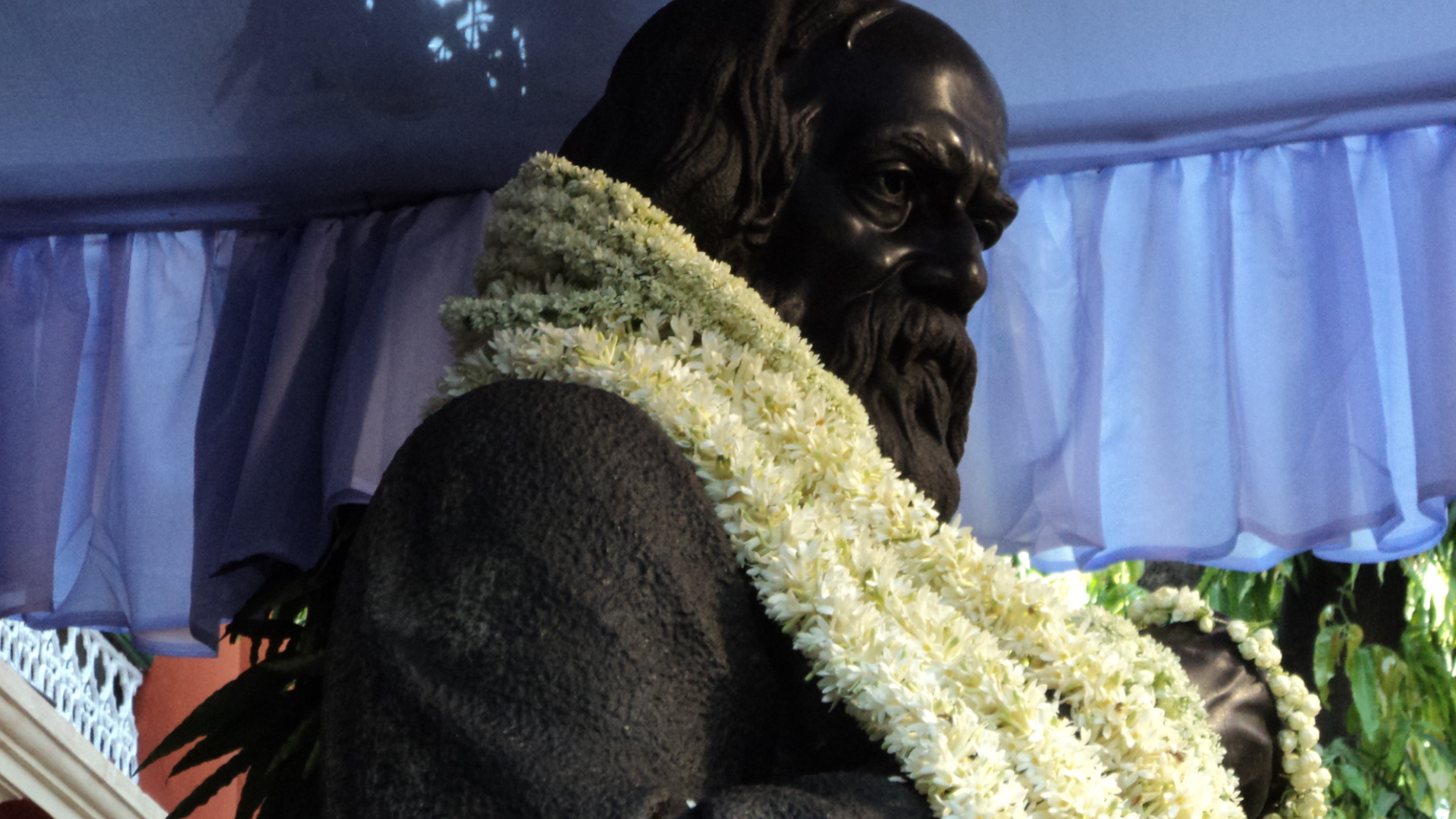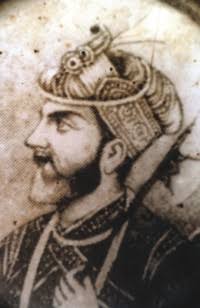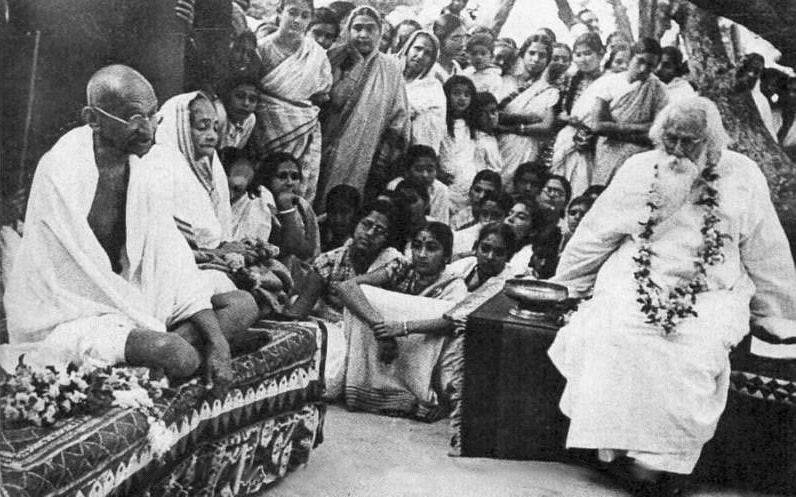|
Dwijendranath Tagore
Dwijendranath Tagore (11 March 1840 вАУ 19 January 1926) was an Indian Bengali poet, song composer, philosopher, mathematician and painter. He was one of the pioneers of shorthand and notation in Bengali script. He was the eldest son of Debendranath Tagore and the eldest brother of Rabindranath Tagore.а¶єа¶ња¶∞а¶£аІНа¶Ѓа¶ѓа¶Љ ඐථаІНබаІЛ඙ඌ඲аІНа¶ѓа¶Ња¶ѓа¶Ља•§ ''ආඌа¶ХаІБа¶∞а¶ђа¶Ња¶°а¶Ља¶ња¶∞ а¶Хඕඌ''а•§ පගපаІБ ඪඌයගටаІНа¶ѓ а¶Єа¶Ва¶Єа¶¶а•§ ඙аІГа¶ЈаІНආඌ аІѓаІЂвАУаІѓаІЃа•§ Early life Dwijendranath Tagore (born on 11 March 1840) was the grandson of Dwarkanath Tagore of the Jorasanko branch of the Tagore family and the eldest son of Debendranath Tagore and Sarada Devi. His childhood education was mainly with the tutor. However, he also studied for some time at St. Paul's School and Hindu College in Calcutta (now Presidency University).а¶ЄаІБа¶ђаІЛа¶І а¶ЪථаІНබаІНа¶∞ а¶ЄаІЗථа¶ЧаІБ඙аІНට; а¶Еа¶ЮаІНа¶Ьа¶≤а¶њ а¶ђаІЛа¶Є, а¶Єа¶ЃаІН඙ඌබа¶Ха ... [...More Info...] [...Related Items...] OR: [Wikipedia] [Google] [Baidu] |
Calcutta
Kolkata (, or , ; also known as Calcutta , List of renamed places in India#West Bengal, the official name until 2001) is the Capital city, capital of the Indian States and union territories of India, state of West Bengal, on the eastern bank of the Hooghly River west of the border with Bangladesh. It is the primary business, commercial, and financial hub of East India, Eastern India and the main port of communication for North-East India. According to the 2011 Indian census, Kolkata is the List of cities in India by population, seventh-most populous city in India, with a population of 45 lakh (4.5 million) residents within the city limits, and a population of over 1.41 crore (14.1 million) residents in the Kolkata metropolitan area, Kolkata Metropolitan Area. It is the List of metropolitan areas in India, third-most populous metropolitan area in India. In 2021, the Kolkata metropolitan area crossed 1.5 crore (15 million) registered voters. The ... [...More Info...] [...Related Items...] OR: [Wikipedia] [Google] [Baidu] |
Jorasanko Thakur Bari
Jorasanko Thakur Bari (Bengali: ''House of the Thakurs''; anglicised to ''Tagore'') in Jorasanko, North Kolkata, West Bengal, India, is the ancestral home of the Tagore family. It is the birthplace of poet Rabindranath Tagore and the host of the Rabindra Bharati University campus. History Jorasanko Thakur Bari was built in the 18th century on the land donated by the Sett family of Burrabazar to вАШPrinceвАЩ Dwarkanath Tagore. Rabindra Bharati University The Rabindra Bharati University was established by the government of West Bengal in 1961 to commemorate the birth centenary of Rabindranath Tagore. Rabindra Bharati Museum The house has been restored to reflect the way the household looked when the Tagore family lived in it and currently serves as the Tagore museum, offering details about the history of the Tagore family including their involvement in the Bengal Renaissance and the Brahmo Samaj. Photography is strictly prohibited inside the museum, but allowed in outside. T ... [...More Info...] [...Related Items...] OR: [Wikipedia] [Google] [Baidu] |
List Of Bengali Language Authors (chronological)
This is a Chronological list of Bengali language authors (regardless of nationality or religion), by the order of their year of birth. Alphabetical order is used only when chronological order cannot be ascertained. The list also marks the winners of major international and national awards: * Nobel Prize winners are marked with * Ramon Magsaysay Award winners are marked with: * Bharat Ratna winners are marked with: * Padma Vibhushan winners are marked with: * Padma Bhushan winners are marked with: * Independence Day Award winners are marked with: * Ekushey Padak winners are marked with: * Banga-Vibhushan winners are marked with: For an alphabetic listing of Bengali language authors please refer to alphabetic list of Bengali language authors. Ancient age * Aryadev (9th century) * Bhusukupa (9th century) * Dhendhanpa (9th century) * Dombipa (9th century) * Kahnapa (9th century) * Kukkuripa (9th century) * Luipa (9th century) * Minapa (9th century) * Sarhapa (9th c ... [...More Info...] [...Related Items...] OR: [Wikipedia] [Google] [Baidu] |
List Of Bengalis
This article provides lists of famous and notable Bengali people in the South Asian subcontinent, mainly what is today Bangladesh, Pakistan and India, and people with Bengali ancestry or people who speak Bengali as their primary language. Monarchs Pala Dynasty ''Chronological order'' Chandra Dynasty * Traillokyachandra (900вАУ930) * Srichandra (930вАУ975) * Kalyanachandra (975вАУ1000) * Ladahachandra (1000вАУ1020) * Govindachandra (Chandra dynasty), Govindachandra (1020вАУ1050) Deva Dynasty * Dasharathadeva (1281) * Pratapaditya, Maharaja of Jessore (city), Jessore (1561вАУ1611) * Kirtinarayan Basu, Raja of Chandradwip (from 1668), converted to Islam Ilyas Shahi dynasty (1352вАУ1414) House of Ganesha * Raja Ganesha * Jalaluddin Muhammad Shah * Shamsuddin Ahmad Shah (1419вАУ1436) Hussain Shahi dynasty (1494вАУ1538) Other * Paragal Khan, 16th-century governor of Chittagong * Chhuti Khan, 16th-century governor of Chittagong * Shahzada Danyal, son of Alauddin Husai ... [...More Info...] [...Related Items...] OR: [Wikipedia] [Google] [Baidu] |
Sharmila Tagore
Sharmila Tagore (also known as Begum Ayesha Sultana; born 8 December 1944) is a retired Indian actress, primarily known for her work in Hindi and Bengali cinema, Tagore is the recipient of two National Film Awards, a Filmfare Award, and the Filmfare Lifetime Achievement Award for her contributions to Hindi cinema. In 2013, the Government of India, honoured her with Padma Bhushan, India's third highest civilian honour for her contributions to the Indian culture through performing arts. Born into the prominent Tagore family, one of the leading families of Calcutta and a key influence during the Bengali Renaissance, Tagore made her acting debut at age 14 with Satyajit Ray's acclaimed Bengali drama ''The World of Apu'' (1959). She went on to collaborate with Ray on numerous other films, including; '' Devi'' (1960), '' Nayak'' (1966), '' Aranyer Din Ratri'' (1970), and ''Seemabaddha'' (1971); thus, establishing herself as one of the most prominent figures in Bengali cinema. Tagor ... [...More Info...] [...Related Items...] OR: [Wikipedia] [Google] [Baidu] |
Soumendranath Tagore
Saumyendranath Tagore (October 8, 1901 вАУ September 22, 1974), son of Sudhindranath Tagore, grandson of Dwijendranath Tagore, and grand-nephew of Rabindranath Tagore, was the leader of the Revolutionary Communist Party of India, and the first translator of The Communist Manifesto into Bengali, which was published in ''Langal'' magazine edited by Kazi Najrul Islam. Education Tagore passed matriculation in 1917 from Mitra Institution in Kolkata and became graduate with Hon's in Economics from the Presidency College in the year of 1921. Communist movement In 1920, Tagore joined the "''Akhil Bharat Chatra Sammelan''" ("All-India Student Conference") in Ahmedabad. He befriended Muzaffar Ahmed and the poet, Kazi Nazrul Islam. After Tagore joined the Workers and Peasants Party (WPP) in April 1926, he began mobilizing the jute millвАРworkers of Bengal to form the Bengal Jute Workers' Association. His effectiveness as a trade union activist and his attempts to win revolutionarie ... [...More Info...] [...Related Items...] OR: [Wikipedia] [Google] [Baidu] |
Rabindra Sangeet
''Rabindra Sangeet'' ( bn, а¶∞а¶ђаІАථаІНබаІНа¶∞ а¶Єа¶ЩаІНа¶ЧаІАට; ), also known as Tagore Songs, are songs from the Indian subcontinent written and composed by the Bengali polymath Rabindranath Tagore, winner of the 1913 Nobel Prize in Literature, the first Indian and also the first non-European to receive such recognition. Tagore was a prolific composer with approximately 2,232 songs to his credit. The songs have distinctive characteristics in the music of Bengal, popular in India and Bangladesh. It is characterised by its distinctive rendition while singing which includes a significant amount of ornamentation like meend, murki, etc. and is filled with expressions of romanticism. The music is mostly based on Hindustani classical music, Carnatic music, Western tunes and the inherent folk music of Bengal and inherently possess within them, a perfect balance, an endearing economy of poetry and musicality. Lyrics and music both hold almost equal importance in Rabindra Sangeet. ... [...More Info...] [...Related Items...] OR: [Wikipedia] [Google] [Baidu] |
Dinendranath Tagore
Dinendranath Tagore (16 December 1882вАУ 21 July 1935), also known as Dinu Thakur, was a Bengali musician, singer and poet.Samsad Bengali Charitabhidhan (Vol.I) ( Biographical Dictionary) edited by Subodhchandra Sengupta & Anjali Bose, August,2016 Edition,Page 283 He codified many of the tunes that would appear impetuously to Rabindranath. He served as principal of Visva-Bharati's Music school, ''Sangit Bhavana'' for its opening years. website. He was the first person who introduced the songs of Tagore as the name of |
Mahatma Gandhi
Mohandas Karamchand Gandhi (; ; 2 October 1869 вАУ 30 January 1948), popularly known as Mahatma Gandhi, was an Indian lawyer, anti-colonial nationalist Quote: "... marks Gandhi as a hybrid cosmopolitan figure who transformed ... anti-colonial nationalist politics in the twentieth-century in ways that neither indigenous nor westernized Indian nationalists could." and political ethicist Quote: "Gandhi staked his reputation as an original political thinker on this specific issue. Hitherto, violence had been used in the name of political rights, such as in street riots, regicide, or armed revolutions. Gandhi believes there is a better way of securing political rights, that of nonviolence, and that this new way marks an advance in political ethics." who employed nonviolent resistance to lead the successful campaign for India's independence from British rule, and to later inspire movements for civil rights and freedom across the world. The honorific ''MahƒБtmƒБ'' (Sanskrit ... [...More Info...] [...Related Items...] OR: [Wikipedia] [Google] [Baidu] |
Santiniketan
Santiniketan is a neighbourhood of Bolpur town in the Bolpur subdivision of Birbhum district in West Bengal, India, approximately 152 km north of Kolkata. It was established by Maharshi Devendranath Tagore, and later expanded by his son, Rabindranath Tagore whose vision became what is now a university town with the creation of Visva-Bharati.Pearson, WW.: ''Santiniketan Bolpur School of Rabindranath Tagore'', illustrations by Mukul Dey, The Macmillan Company, 1916 History In 1863, Debendranath Tagore took on permanent lease of land, with two ( Alstonia scholaris) trees, at an annual payment of Rs. 5, from Bhuban Mohan Sinha, the talukdar of Raipur, Birbhum. He built a guest house there and named it ''Shantiniketan'' (the abode of peace). Gradually, the whole area came to be known as Shantiniketan.Basak, Tapan Kumar, ''Rabindranath-Santiniketan-Sriniketan (An Introduction)'', p. 2, B.B.Publication Binoy Ghosh says that Bolpur was a small place in the middle of the 19th ... [...More Info...] [...Related Items...] OR: [Wikipedia] [Google] [Baidu] |
Hindu Mela
Hindu ''Mela'' was a political and cultural festival started in 1867 in Calcutta. Its primary objective was to instill a sense of national pride among the city-dwellers to indigenous handmade products rather than imported British-made products. It included the display of ''swadeshi'' wrestling, ''swadeshi'' art and recital and performances of ''swadeshi'' poetry and songs. The ''mela'' met regularly until 1880 after which it lost its importance due to the establishment of other institutions. Founding In 1867, the National Paper published the ''Prospectus of a Society for the Promotion of National Feeling among the Educated Natives of Bengal'' by Rajnarayan Basu. Inspired by this booklet Nabagopal Mitra founded the Hindu ''Mela'' and the National Society in 1867. The ''mela'' was first known as the ''Chaitra Mela''. The founding of the ''mela'' was supported financially by the Tagore family of Jorashako. Members of the Tagore family recited poetry and performed songs at the even ... [...More Info...] [...Related Items...] OR: [Wikipedia] [Google] [Baidu] |
Braja Sundar Mitra
Braj, also known as Vraj, Vraja, Brij or Brijbhoomi, is a region in India on both sides of the Yamuna river with its centre at Mathura-Vrindavan in Uttar Pradesh state encompassing the area which also includes Palwal and Ballabhgarh in Haryana state, Bharatpur district in Rajasthan state and Morena District in Madhya Pradesh.Janet Cochrane, 2008Asian Tourism: Growth and Change page 249. Within Uttar Pradesh it is very well demarcated culturally, the area stretches from the Mathura, Aligarh, Agra, Hathras and districts up to the Farrukhabad, Mainpuri and Etah districts. Braj region is associated with Radha and Krishna who according to scriptures were born in Barsana and Mathura respectively. It is the main centre of Krishna circuit of Hindu pilgrimage. It is located 150 km south of Delhi and 50 km northwest of Agra. Etymology The term Braj is derived from the Sanskrit word ''vraja (৵а•На§∞а§Ь)''. Vraja was first mentioned in Rigveda, and in Sanskrit it means a p ... [...More Info...] [...Related Items...] OR: [Wikipedia] [Google] [Baidu] |


.jpg)



